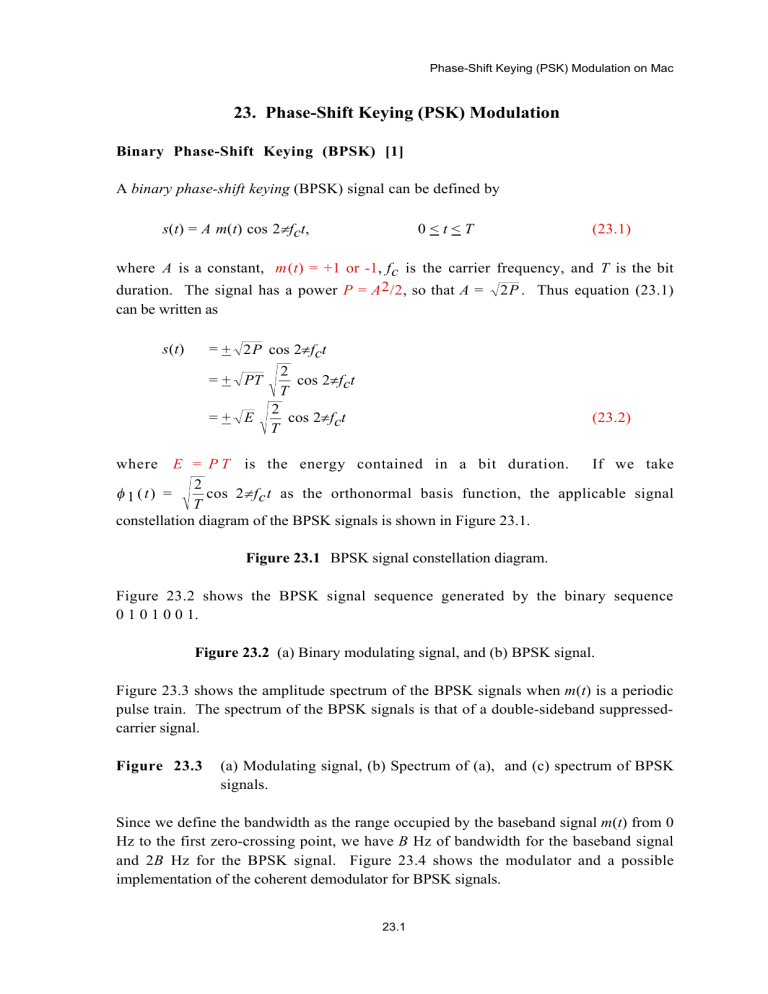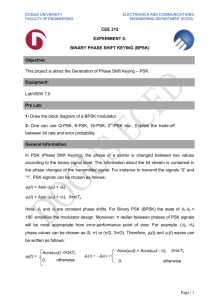23. Phase-Shift Keying (PSK) Modulation
advertisement

Phase-Shift Keying (PSK) Modulation on Mac 23. Phase-Shift Keying (PSK) Modulation Binary Phase-Shift Keying (BPSK) [1] A binary phase-shift keying (BPSK) signal can be defined by s(t) = A m(t) cos 2πfct, 0<t<T (23.1) where A is a constant, m(t) = +1 or -1, f c is the carrier frequency, and T is the bit duration. The signal has a power P = A 2 /2, so that A = 2P . Thus equation (23.1) can be written as s(t) = + 2P cos 2πfct = + PT =+ E 2 cos 2πfct T 2 cos 2πfct T (23.2) where E = P T is the energy contained in a bit duration. If we take 2 cos 2π f c t as the orthonormal basis function, the applicable signal φ 1 ( t) = T constellation diagram of the BPSK signals is shown in Figure 23.1. Figure 23.1 BPSK signal constellation diagram. Figure 23.2 shows the BPSK signal sequence generated by the binary sequence 0 1 0 1 0 0 1. Figure 23.2 (a) Binary modulating signal, and (b) BPSK signal. Figure 23.3 shows the amplitude spectrum of the BPSK signals when m(t) is a periodic pulse train. The spectrum of the BPSK signals is that of a double-sideband suppressedcarrier signal. Figure 23.3 (a) Modulating signal, (b) Spectrum of (a), and (c) spectrum of BPSK signals. Since we define the bandwidth as the range occupied by the baseband signal m(t) from 0 Hz to the first zero-crossing point, we have B Hz of bandwidth for the baseband signal and 2B Hz for the BPSK signal. Figure 23.4 shows the modulator and a possible implementation of the coherent demodulator for BPSK signals. 23.1 Phase-Shift Keying (PSK) Modulation on Mac Figure 23.4 (a) BPSK modulator, and (b) coherent demodulator. M-ary Phase-Shift Keying (M-PSK) [2-4] An M-ary phase-shift keying (M-PSK) signal can be defined by A cos( 2π fc t + θ i + θ ' ) , 0 ≤ t ≤ T s(t) = elsewhere 0, (23.3) θ i = 2π i M (23.4) where for i = 0, 1, ..., M - 1. Here, A is a constant, f c is the carrier frequency, θ ' is the initial phase angle, and T is the symbol duration. By expanding equation (23.3), we have s(t) = Acosθi cos(2πfct+θ') - Asinθi sin(2πfct+θ') The signal has a power P = A 2 /2, so that A = written as s(t) = PT cosθi = E cosθi 2 cos(2πfct+θ') T 2 cos(2πfct+θ') T (23.5) 2P . Thus equation (23.5) can be PT sinθ i E sinθ i 2 sin(2πfct+θ') T 2 sin(2πfct+θ') T (23.6) where E = PT is the energy of s(t) contained in a symbol duration for i = 0, 1, ..., M - 1. For convenience, the arbitrary phase angle θ ' is taken to be zero. If we take 2 2 cos 2π f c t and φ 2 (t) = sin 2π fc t as the orthonormal basis functions, φ 1 (t) = T T the applicable signal constellation diagrams of the M-PSK and 4-PSK signals are shown in Figure 23.5. All signal points lie on a circle of radius E . Figure 23.5 (a) M-PSK and (b) 4-PSK signal constellation diagrams. Figure 23.6 shows the 4-PSK signal sequence generated by the binary sequence 00 01 10 11. Figure 23.6 4-PSK modulation: (a) binary sequence and (b) 4-PSK signal. 23.2 Phase-Shift Keying (PSK) Modulation on Mac Figure 23.7 shows the modulator and a possible implementation of the coherent demodulator for M-PSK signals [3, 4]. Figure 23.7 (a) M-PSK modulator, and (b) coherent demodulator. We may use the mapping table shown in Table 23.1 for the phase-to-binary-vector conversion. ________________________________________________________________________ θi Natural binary vector ________________________________________________________________________ 0 0 0 ... 0 0 2π 0 0 ... 0 1 M 2( 2π ) 0 0 ... 1 0 M : : (M-1) 2π 1 1 ... 1 1 M ________________________________________________________________________ Table 23.1 A possible mapping table for M-PSK coherent demodulation. References [1] M. Schwartz, Information Transmission, Modulation, and Noise, 4/e, McGraw Hill, 1990. [2] P. Z. Peebles, Jr., Digital Communication Systems, Prentice Hall, 1987. [3] J. D. Gibson, Principles of Digital and Analog Communications, MacMillan, 1990. [4] B. Sklar, Digital Communications: Fundamentals and Applications, Prentice Hall, 1988. 23.3 Phase-Shift Keying (PSK) Modulation on Mac s s 0 0 - E φ ( t ) = 2 cos 2 π f t 1 c T 1 E Figure 23.1 BPSK signal constellation diagram. Binary sequence 0 1 0 1 0 0 1 m (t ) 1 Time 0 -1 T (a) s (t ) BPSK signal A -A Time 0 (b) Figure 23.2 (a) Binary modulating signal, and (b) BPSK signal. 23.4 Phase-Shift Keying (PSK) Modulation on Mac M( f ) Envelope m (t) 0 1 1 T 0 -1 0 1 2T 1 t 2T 3T -3 -2 T T -1 0 B =1 T T 2 T f 3 T (b) (a) S (f) Envelope 1 2T 1 2T 2B 2B ... -f c - 3 T 1 -f c T -f c Figure 23.3 ... 0 -f c + 1 T f fc - 3 T -f c + 3 T fc - 1 T fc fc + 1 T fc + 3 T (a) Modulating signal, (b) Spectrum of (a), and (c) spectrum of BPSK signals. m (t ) x 0.5 A m ( t ) cos 4 π f c t + 0.5 A m ( t ) s (t ) A cos 2 π f c t s (t ) ~ ~ x 0.5A m ( t ) cos 2 π f c t (a) (b) Figure 23.4 (a) BPSK modulator, and (b) coherent demodulator. 23.5 Phase-Shift Keying (PSK) Modulation on Mac φ ( t ) = - 2 sin 2 π f t 2 c T 0 φ (t ) 2 s1 s1 ( E cos θ , E sin θ ) 1 1 E 2π s θ 1= 0 M φ ( t ) = 2 cos 2 π f t 1 c T s0 s2 0 E φ (t ) 1 s3 (b) (a) Figure 23.5 (a) M-PSK and (b) 4-PSK signal constellation diagrams. Binary sequence 0 0 0 1 1 0 1 1 1 Time 0 (a) s (t ) 4-PSK signal A -A Time 0 T T (b) Figure 23.6 4-PSK modulation: (a) binary sequence and (b) 4-PSK signal. 23.6 Phase-Shift Keying (PSK) Modulation on Mac log M bits 2 Serial Binary to sequence parallel converter cos θ i Assign a phase θi : x + s (t ) Σ A cos 2 π f c t sin θ i x A sin 2 π f c t (a) x s (t ) 0.5A cos θ i cos 4 π f c t 0.5 A sin θ i sin 4 π f c t + 0.5 A cos θ i ~ ~ 0.5 A cos θ i cos 2 π f c t ^ -1 0.5 A cos θ i sin 4 π f c t + θ i = tan (.) 0.5A sin θ i cos 4 π f c t 0.5A sin θ i ~ x ~ -0.5 A sin θ i Binary Mapping sequence table sin 2 π f c t (b) Figure 23.7 (a) M-PSK modulator, and (b) coherent demodulator. 23.7









